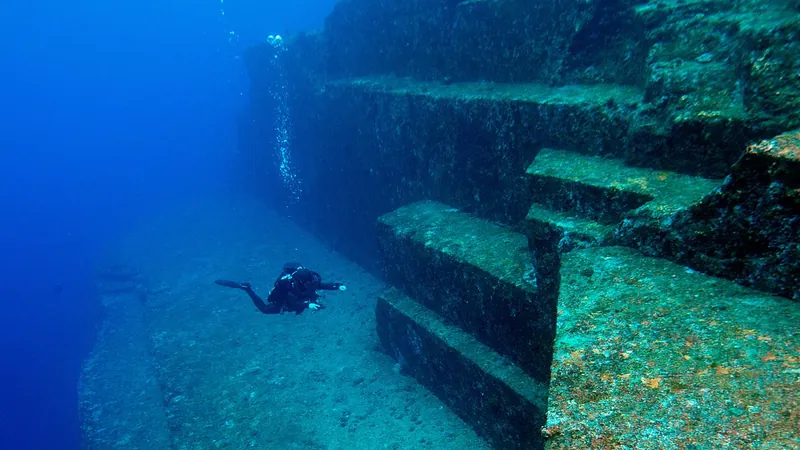
Unveiling Japan's Underwater 'Pyramid': Could This 12,000-Year-Old Structure Redefine Human History?
2025-04-08
Author: Ken Lee
Introduction
A submerged 'pyramid' near Taiwan is capturing the imagination of historians and archaeologists alike, as evidence mounts that it may potentially redefine our understanding of ancient civilizations. Located just 82 feet below sea level near the Ryukyu Islands of Japan, the enigmatic Yonaguni Monument has puzzled researchers since its discovery in 1986.
Description and Age
This massive structure, towering approximately 90 feet, boasts sharp-angled steps and is primarily composed of stone, leading some experts to suggest that it may be a man-made artifact. Remarkably, scientific analysis indicates that the stone could be over 10,000 years old, positioning the monument's construction well before the area submerged underwater—dating it back to a staggering 12,000 years ago.
Historical Implications
If this pyramid-like structure was indeed constructed by advanced civilization so long ago, it would predate other ancient marvels, including the Great Pyramids of Egypt and Stonehenge, by thousands of years. This challenges the established narrative that large architectural endeavors only arose alongside the advent of agriculture around 10,000 years ago.
Speculation and Debate
Speculation suggests that this ancient site could unlock secrets about previously unknown societies—drawing comparisons to the legendary Atlantis. Consequently, the Yonaguni Monument has been dubbed 'Japan's Atlantis,' yet many skeptics question its man-made origins. In a recent heated debate on the Joe Rogan Experience podcast, renowned author Graham Hancock and geologist Flint Dibble sparred over the monument's authenticity.
Arguments For and Against Man-Made Origins
Dibble, dismissing claims of human craftsmanship, maintained that the features observed were purely geological. 'I've seen a lot of crazy natural stuff and I see nothing here that reminds me of human architecture,' he insisted. In contrast, Hancock argued that the features visible in photographs indicate clear signs of human construction, including arches, megaliths, and terraces.
Broader Context of Ancient Civilizations
The implications of Yonaguni's origins are profound. Should it be established that this monument is an ancient human construct, it could join other archaeological wonders, such as Göbekli Tepe in Turkey, which is believed to be around 12,000 years old, pushing back the timeline of human innovation and complexity.
Moreover, another ancient site, Gunung Padang in Indonesia, which was rediscovered by Dutch explorers in the 19th century, is posited to potentially predate both Göbekli Tepe and Yonaguni by thousands of years. This mysterious structure has been found to contain megaliths dating back over 16,000 years, suggesting that advanced societies emerged much earlier than previously thought.
Scientific Perspectives
Dr. Masaaki Kimura, the scientist behind the age testing of the Yonaguni structure, claims that the debate surrounding its origins is far from over. He notes that during the time the monument would have been constructed, it was likely above water, before the rapid rise in global sea levels triggered by the melting of massive ice sheets at the end of the last Ice Age.
The compelling evidence presented by both proponents and skeptics alike highlights the complexity of the situation. Dr. Robert Schoch, a geologist from Boston University, presents a counter-narrative, arguing that the features of Yonaguni could be attributed to natural geological processes.
Conclusion
As the investigation into the Yonaguni Monument continues, it stands at the center of a captivating dialogue about humanity's capability and the story of our ancestors. If proven to be man-made, it may not only add to our collection of wonders but also ignite a new chapter in the history of human civilization—further proving that our past may hold more mysteries than we can currently comprehend.
Will the truth about Japan’s underwater pyramid finally emerge, and could it truly rewrite our history? Only time, and perhaps further exploration, will tell!


 Brasil (PT)
Brasil (PT)
 Canada (EN)
Canada (EN)
 Chile (ES)
Chile (ES)
 Česko (CS)
Česko (CS)
 대한민국 (KO)
대한민국 (KO)
 España (ES)
España (ES)
 France (FR)
France (FR)
 Hong Kong (EN)
Hong Kong (EN)
 Italia (IT)
Italia (IT)
 日本 (JA)
日本 (JA)
 Magyarország (HU)
Magyarország (HU)
 Norge (NO)
Norge (NO)
 Polska (PL)
Polska (PL)
 Schweiz (DE)
Schweiz (DE)
 Singapore (EN)
Singapore (EN)
 Sverige (SV)
Sverige (SV)
 Suomi (FI)
Suomi (FI)
 Türkiye (TR)
Türkiye (TR)
 الإمارات العربية المتحدة (AR)
الإمارات العربية المتحدة (AR)